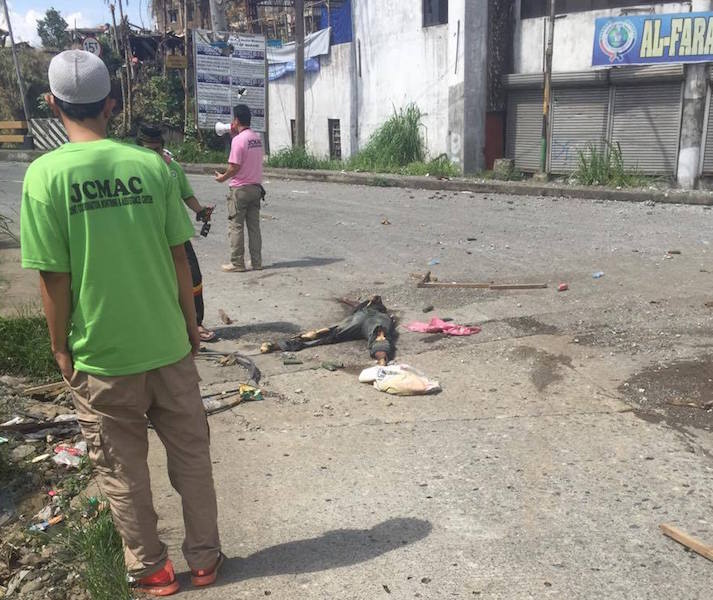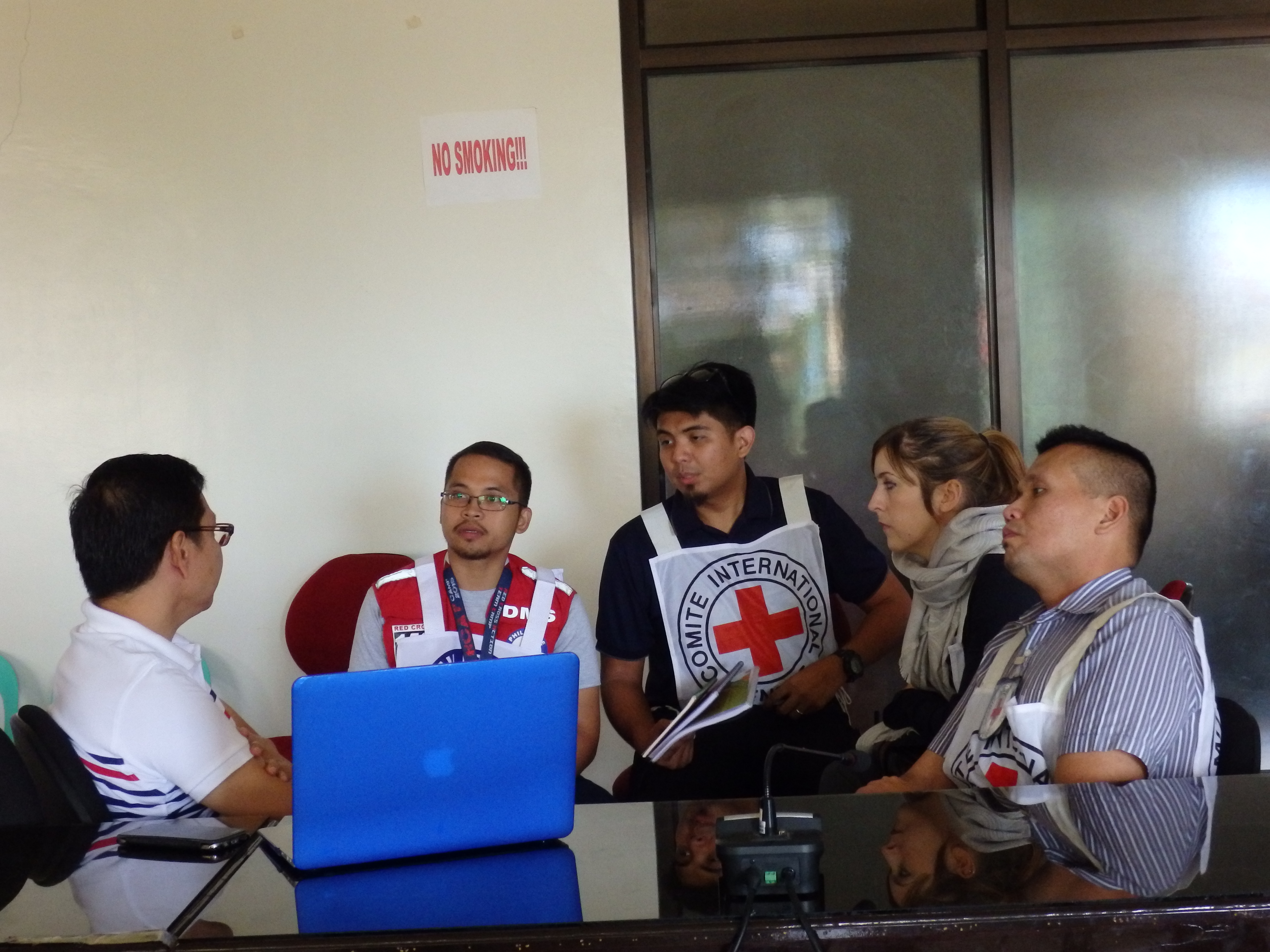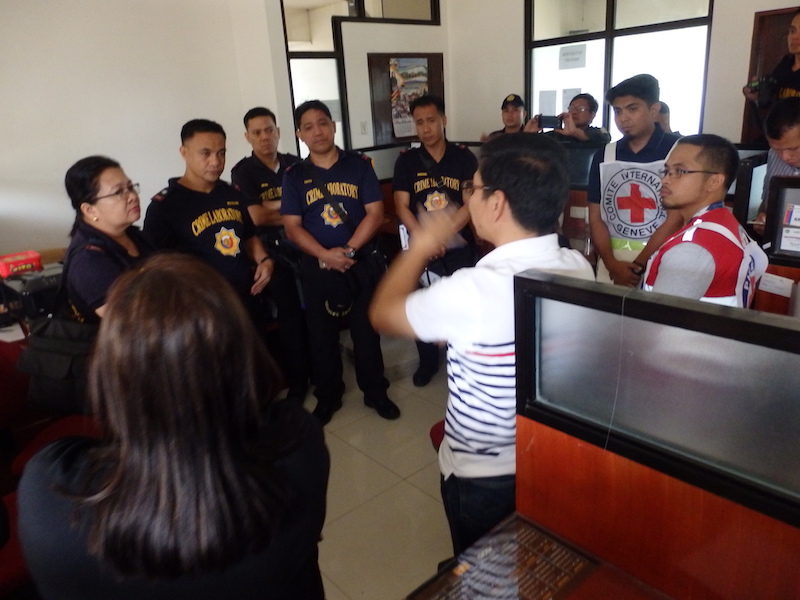MARAWI CITY (MindaNews / 10 June) — As bombs dropped from the skies on areas held by the Maute Group Friday, the Provincial Crisis Management Committee (PCMC) spent the day meeting with agencies to prepare for the retrieval of the dead in the conflict zone once the military declares these areas cleared.
Volunteer rescuers were also gathered to attend a crash course on retrieving dead bodies, conducted by the International Committee of the Red Cross (ICRC) and the Philippine Red Cross (PRC).
 The body of a slain civilian along Gomisa Avenue leading to Banggolo district on June 4, 2017. awaits retrieval. Volunteer rescuers could not retrieve the dead bodies then as their priority within the four-hour humanitarian ceasefire Photo courtesy of ARIEL AMEROL
The body of a slain civilian along Gomisa Avenue leading to Banggolo district on June 4, 2017. awaits retrieval. Volunteer rescuers could not retrieve the dead bodies then as their priority within the four-hour humanitarian ceasefire Photo courtesy of ARIEL AMEROL
Lawyer Naguib Sinarimbo, PCMC Coordinator and member of the Secretariat, told MindaNews that while conducting rescue operations to save lives remains the priority, “we are also conscious of the fact that the fighting has dragged on for a long time and as the day passes by, we have to contend with the reality that the chances of survival especially of those who have been injured decreases.”
Sinarimbo said there is a need to “calibrate our preparation as we may need to deploy for retrieval, which is why we are also training our rescue teams.”
PCMC spokesperson Zia Alonto Adiong and Lt. Col. Jo-Ar Herrera, spokesperson of the 1st Infantry Division told a press briefing Friday that they estimate the number of trapped civilians at “500 to 1,000.”
A day earlier. Brig. Gen. Rolando Joselito Bautista, 1st Infantry Division chief said there are about 100 hostages still held by the Maute Group, including Fr. Teresito “Chito” Soganub, the Vicar-General of the Prelature of Marawi.
 A delegation from the International Committee of the Red Cross and the Philippine Red Cross discusses with Naguib Sinarimbo, Coordinator at the Provincial Crisis Management Committee on Friday, 09 June 2017, the preparations for retrieval of the dead once the areas are declared cleared by the military. MindaNews photo by CAROLYN O. ARGUILLAS
A delegation from the International Committee of the Red Cross and the Philippine Red Cross discusses with Naguib Sinarimbo, Coordinator at the Provincial Crisis Management Committee on Friday, 09 June 2017, the preparations for retrieval of the dead once the areas are declared cleared by the military. MindaNews photo by CAROLYN O. ARGUILLAS
A delegation from the ICRC and the PRC came to the Operations Center of the PCMC early Friday morning to discuss the retrieval process and get volunteers to attend the crash course on retrieval.
By noon a delegation wearing SOCO (Scene of the Crime Operations) and DVI (Disaster Victims Identification) arrived and also discussed retrieval protocols with Sinarimbo.
Friday was Day 18 of the Marawi Crisis that the military hopes to end by June 12, Day 21.
A coordination meeting was agreed upon for 7:30 a.m. on Saturday, Day 19.
Police Supt. Mary Leocy Imag-Abo, Regional Chief of the Regional Crime Laboratoy in Northern Mindanao, who led the team in coordinating with Sinarimbo on Friday told MindaNews that there are three SOCO teams — from the Autonomous Region in Muslim Mindanao, Northern Mindanao and Caraga region — along with a team of four from DVI of the Philippine National Police’s Crime Laboratory in Camp Crame, that have been deployed to attend to the retrieval process here.
Abo said the DVI team had just finished their work on the Resorts World incident in Manila.
 The Philippine National Police’s Crime Laboratory has three teams of SOCO (Scene of the Crime Operatives) from the Autonomous Region in Muslim Mindanao, Northern Mindanao and Caraa region, and a DVI (Disaster Victims Identification) team from Camp Crame, Quezon City deployed to Marawi for the identification of the dead. The regional crime laboratory chief in Northern Mindanao, Supt. Mary Leocy Imag-Abo, accompanied the teams to Marawi City for coordination with the Provincial Crisis Management Committee oFriday noon, 09 June 2017. MindaNews photo by CAROLYN O. ARGUILLAS
The Philippine National Police’s Crime Laboratory has three teams of SOCO (Scene of the Crime Operatives) from the Autonomous Region in Muslim Mindanao, Northern Mindanao and Caraa region, and a DVI (Disaster Victims Identification) team from Camp Crame, Quezon City deployed to Marawi for the identification of the dead. The regional crime laboratory chief in Northern Mindanao, Supt. Mary Leocy Imag-Abo, accompanied the teams to Marawi City for coordination with the Provincial Crisis Management Committee oFriday noon, 09 June 2017. MindaNews photo by CAROLYN O. ARGUILLAS
She said the collected remains will be placed in body bags and transported directly to a funeral parlor in Iligan City for processing and identification.
Muslims bury their dead within 24 hours.
Sinarimbo said the Bureau of Fire Protection is the focal agency in the retrieval process. He said it was agreed upon during the coordinating meeting that if there is a substantial number of remains to be retrieved, “we will designate a temporary holding area in Marawi for documentation before we transport to Iligan all bodies.”
Rescuers from the Moro Islamic Liberation Front (MILF) in the government-GPH Peace Corridor on June 4 saw a number of cadavers on the roadside but could not collect them as the priority was to get trapped civilians out. Rescued civilians as well narrated having seen decomposing bodies along the way.
Ariel Amerol, manager of the Bangsamoro Development Agency and one of the volunteer rescuers on June 2 said they saw one body of a civilian along Gomisa Avenue on the way to Banggolo District but they were informed there wer emore bodies in the interiors.
The retrieval protocols will consider religious and cultural practices, Sinarimbo said, adding “we will first consult with our Ulama here given the requirements of SOCO for identification and the impossibility of doing identification by seondary means” and the tradition observed by Muslims to bury the dead within 24 hours.
Marawi is predominantly Muslim.
Like other mass casualty incidents, bodies that may be retrieved may be beyond recognition but Abo said DNA tests will be conducted to identify the dead.
The list of the missing is still being collated. DNA tests on the dead, taken from tissue samples, will have to be matched with the DNA of relatives.
DNA samplings were also taken from the remains of the victims of typhoons Sendong in Cagayan de Oro and Iligan cities in 2011 and Pablo in New Bataan, Compostela Valley in 2012 but until now, relatives are still awaiting the results of the matchings. (Carolyn O. Arguillas / MindaNews)
